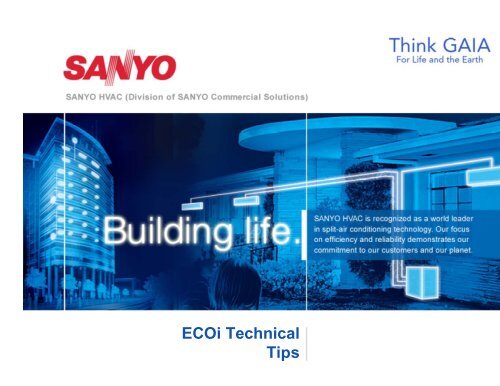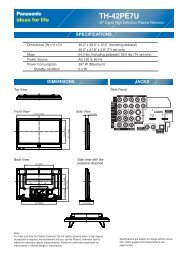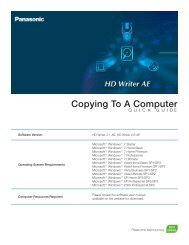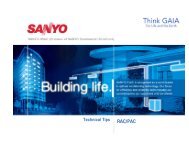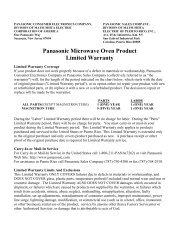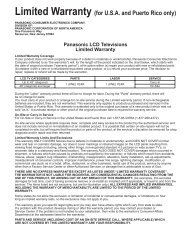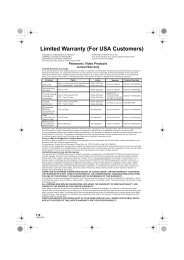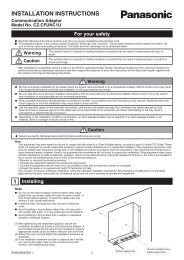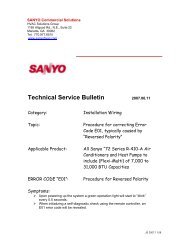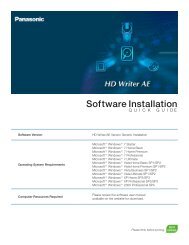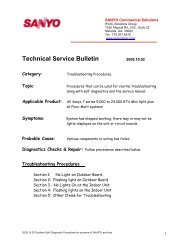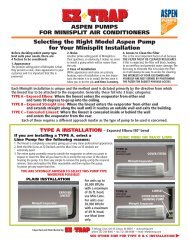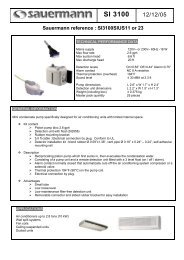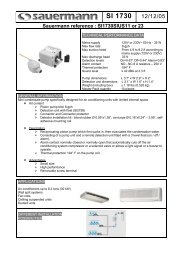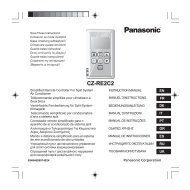2010 ECO-i Tech Tips - Panasonic
2010 ECO-i Tech Tips - Panasonic
2010 ECO-i Tech Tips - Panasonic
You also want an ePaper? Increase the reach of your titles
YUMPU automatically turns print PDFs into web optimized ePapers that Google loves.
<strong>ECO</strong>i <strong>Tech</strong>nical<br />
<strong>Tips</strong>
Refrigerant Properties<br />
Higher Pressure (R410A is 1.6 times higher than R22.)<br />
Compressor oil is different.<br />
R410A uses Polyol Esther Oil (Synthetic fluid)<br />
Different Gauge-manifold, Charge hose, etc., must be used for<br />
R410A.<br />
Near-Azeotrope Type Refrigerant<br />
Only charge the refrigerant in liquid form.
U Series<br />
Increasing fan Speed<br />
If External static pressure is too great (due to long extension of ducts, for example), the air flow volume may drop<br />
too low at each air outlet. This problem may be solved by increasing the fan speed using the following procedure:<br />
1. Remove 4 screws on the electrical component box and remove the cover plate.<br />
2. Disconnect the fan motor sockets in the box.<br />
3. Securely connect the booster cable sockets between the disconnected fan motor sockets as shown below.<br />
4. Place the cable neatly in the box and re-install the cover plate.
Indoor Unit Power Requirements<br />
All Eco-I indoor units require a 208/230 VAC single<br />
phase power supply. Each indoor unit should be<br />
supplied with a field supplied disconnect switch.<br />
Ex: Typical Wiring Connections at Indoor Unit<br />
208/230 VAC Power Supply<br />
Ground<br />
Interconnecting Shielded<br />
Control Wires<br />
Remote Control<br />
Shielded Wire<br />
115 VAC<br />
115 VAC<br />
12 VDC<br />
Disconnect Switch<br />
Field Supplied<br />
Shield must be grounded on one end<br />
12-15VDC<br />
L1<br />
L2<br />
G<br />
U1<br />
U2<br />
R1<br />
R2<br />
Indoor unit terminal strip
A good communication line should read around 100<br />
ohm’s at both the indoor and outdoor unit.<br />
Indoor unit at U1 & U2 communication line Outdoor unit at U1 & U2 communication line
Power Requirements for Mini-Eco-I 3 & 5 Ton
Possible Causes:<br />
The Dip switches for the number of indoor units is set incorrectly<br />
One or more of the indoor units is not powered on.<br />
The U1 & U2 communication is: broken, wired incorrectly, loose terminal connection at one or more of the<br />
indoor units terminal block
Inter-Units Inter Units control wiring : Not polarity<br />
Do not connect such as star wiring.<br />
: Star wiring<br />
star<br />
Prohibited<br />
star
• Change in Shield grounding procedure<br />
• Ground Shield only one end
• Ground Shield wire only at one end<br />
•
•<br />
Heat Sink Paste<br />
When replacing a circuit board<br />
Apply a thin layer of Heat Sink Paste (Supplied) on the HIC and Main PCB boards on the outdoor units
Installing Distribution Joint<br />
The direction of the distribution joint kit should be horizontal<br />
or vertical.<br />
The direction of each I/U must<br />
be upward (15~30).<br />
● It is suggested that soft-drawn, ACR grade tubing be used in all cases<br />
to minimize equivalent length of tubing run, and leak potential.<br />
● Hard-drawn tubing may be used, if necessary, with long radius elbows.<br />
● 15% silver brazing material is recommended on all solder joints.<br />
● Factory supplied distribution joints (purchased separately) must<br />
be used where specified.<br />
● Field installed ball valves, with access ports, are recommended on<br />
both branch lines to an indoor unit.
L2<br />
LM LA<br />
H1<br />
H2<br />
LB<br />
m1<br />
LC<br />
m2<br />
m3 m4<br />
Items Reference Contents<br />
Allowable<br />
tubing length<br />
Allowable<br />
elevation<br />
difference<br />
L1<br />
Max tubing length<br />
m5<br />
L1<br />
Mini Eco-i W-Multi<br />
Actual length < 492
Refrigerant Pre-Charge Amount<br />
The refrigerant charge shipped with the<br />
condenser from the factory is what is<br />
needed for the condenser section only.<br />
Once additional piping is installed to the<br />
system it will become necessary to add<br />
an additional amount of refrigerant. This<br />
calculation is figured out by measuring<br />
the sizes and distances of the total length<br />
of liquid line piping installed in feet . All<br />
liquid line sizes must be considered.
Evacuation and Charging Procedures<br />
Always leak check your connections with Nitrogen. We at Sanyo recommend the 3 stage pressure<br />
test. 1st stage 200 psig, 2nd stage 300 psig and then 3rd stage 450 psig. Make sure system holds<br />
nitrogen pressure for a 24 hour period.<br />
1. Once, all connections have been leak tested, the system will need to be evacuated down to at<br />
least 500 microns. A micron vacuum gauge is required for an accurate measurement<br />
of vacuum. The triple evacuation method is strongly recommended.<br />
2. Next calculate additional charge amount and introduce to the system in a liquid form. Please<br />
note there is no additional<br />
compressor oil needed. Always use an accurate digital<br />
refrigerant charging scale for proper charging.
Additions to Refrigerant Piping<br />
Sanyo does not recommend any of the following to be<br />
installed into the refrigerant system piping:<br />
Suction or liquid line driers<br />
Sight Glasses<br />
Oil Traps<br />
Solenoid valves<br />
DO NOT CHANGE THE SIZE OF THE REFRIGERANT<br />
PIPING FROM ANY SIZE OTHER THEN SPECIFIED
Summary of Rotary Dials and Dip Switch Settings<br />
(CN100) A.ADD Pins: These pins are used to initiate auto addressing procedure. (8 & 12 Ton)<br />
(CN51) A.ADD Pins: These pins are used to initiate auto addressing procedure. (3 & 5 Ton)<br />
(S002): Outdoor system address setting switch. Black Knob<br />
(S003): Dip switch setting when outdoor system address exceeds 9 outdoor units.<br />
(S004): Switch setting for the number of indoor units hooked up to the outdoor unit. Red Knob<br />
(S005): Dip switch setting when indoor unit address exceeds 9 indoor units.<br />
(S006): Identifies outdoor unit as #1 or #2 in the case units are piped together as one.<br />
(S007): Determines which system is the Main unit and which is the Sub unit.<br />
(S010): Identifies how to switch between inverter compressor and constant volume<br />
compressor in the event of a failure of either compressor.<br />
(Terminal Plug): Used when outdoor unit S-Net wiring is linked between outdoor units.
Alarm Types & Codes<br />
Reminders<br />
Download a service manual from www.us.sanyo.com<br />
When an alarm occurs reset the system power and wait 10 minutes<br />
then re apply power. Did the system reset?<br />
Keep accurate records of alarms and solutions.<br />
Many error codes are power related. Meaning loss of power to a<br />
component.<br />
and can be reset with cycling the system power.<br />
If an indoor or outdoor board has been replaced the EPROM chip<br />
must also<br />
be replaced or an error stating unit mismatch or similar will occur.
Main things to remember<br />
Complete piping pressure test with 450 psi dry nitrogen.<br />
Evacuate and hold system to minimum of 500 microns.<br />
Calculate and add additional R-410A refrigerant charge in liquid form.<br />
Open outdoor unit service valves.<br />
Be sure to apply power to outdoor unit five hours prier to start up to allow crankcase heater to operate.<br />
Set outdoor unit rotary & dip switches to proper system configuration.<br />
Apply power to all indoor units to be addressed.<br />
Initiate auto-addressing sequence by shorting CN100 pins or CN51pins on respective outdoor unit board. Check and correct alarms, if any.<br />
E24 = Noise interference Remove the blue, pink, black, white wires from the bundle. These are the communication wires on<br />
terminals 1, 2, 3, and 4 for the communication line.<br />
P05 = Phase in-balance Reverse two leads from line voltage. Put your high leg on terminal 3<br />
If you run into an E alarm check the following<br />
U1 and U2 shielded control wiring is open, shorted or not daisy chained properly.<br />
Indoor units are not being powered. No communication with the outdoor unit.<br />
Outdoor unit rotary or dip switches not set properly.


